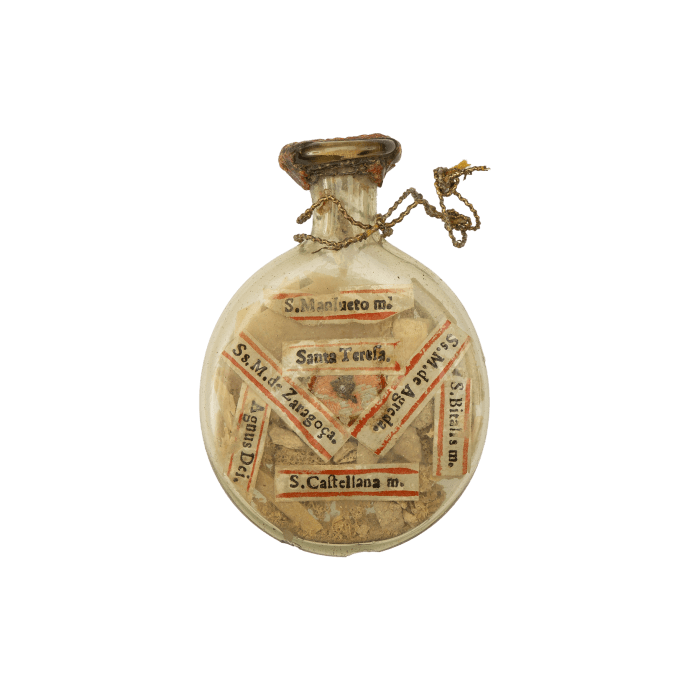


Flask-shaped Glass Reliquary
, Spain, 17th century


Flask-shaped Glass Reliquary
Description
This is a rare survival of a Spanish glass reliquary containing all its relics, untouched since it was sealed. The relics were selected by the original owner for personal protection against illness and misfortune. The reliquary is composed of a flat glass flask (ampulla), round in shape, with metallic thread wrapped around the neck, sealed with wax. The ampulla contains bone fragments, a textile roundel, and a colored engraving of a bearded saint in prayer. The relics are identified by authentics printed on paper in black ink and outlined in red: Saint Mansuetus, martyr; Santa Teresa of Ávila; Saint Vitalis, martyr; Saint Castellana, martyr; the Madonna of Zaragoça (Nuestra Señora del Pilar, Zaragoza); the Madonna of Ágreda (Nuestra Señora de los Milagros, Agreda); and an Agnus Dei (blessed wax from paschal candle). The reliquary is in good condition but shows signs of age and wear.
Literature:
The shape of this flask goes back to early Christian ampullae collected by pilgrims containing relics such as holy water, holy oils, and dust from holy shrines. These were made of either glass, terracotta, or tin-lead. The flat shape of the surface allowed the reliquary to be worn around the neck, suspended as a pendant, placed in a pouch on the body, or displayed at home. The reliquary here could have been used in any of these ways. Its contents were believed to transfer spiritual powers and divine protection to the owner. See: exh. cat. Treasures of Heaven: Saints, Relics, and Devotion in Medieval Europe, London 2011, pp. 5 ff. and cat. nos. 21-24.
The patron saints, much venerated in seventeenth-century Spain, are identified by the authentics. Saint Teresa of Ávila (1515-1582), a mystic and founder of the Discalced Carmelites, was canonized in 1622. Saint Mansueto, perhaps also depicted in the small engraving within the flask, was Bishop of Milan (c. 681). Saint Mansueto had a popular shrine in the Collegiate Church of San Cárlos Borroméo, containing the saint’s body and a flask of his blood. The martyr Saints Vitalis (died in Bologna in the third century) and Castellana are lesser known. The miracle-working statues of the Madonna de Zaragoça and the Madonna de Ágreda attracted pilgrims for centuries. The Agnus Dei dates to early Christianity; it is a disc made from the remnants of the Pascal candle of the previous Easter combined with dust from relics and imprinted with an image of the Lamb of God. This custom is followed in many Catholic countries. For a Spanish example see: Muller, Jewels in Spain 1500-1800, 2012, p. 79. An unpublished example of a late sixteenth-century Spanish glass reliquary for Saint Margaret is in the Corning Museum of Glass in Corning, New York (inv. no. 61.3.110).